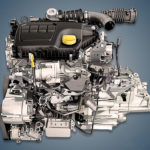The 2.0-liter 8-valve Peugeot DW10TD engine belongs to a large series of 2.0 HDi diesel engines. This power unit was produced from 1999 to 2006 in three different versions: RHY – for passenger car models, RHX – for minivans or RHV – for minibuses.
The DW10 line includes: DW10TD, DW10ATED, DW10ATED4, DW10BTED4, DW10CTED4, DW10DTED4, DW10FCTED4, DW10FDTED4.
DW10TD motor device:
- Cast iron in-line 4-cylinder block without liners;
- Aluminum 8-valve cylinder head with 1 camshaft;
- Fuel system Common Rail Bosch CP1 or Siemens SDI 801;
- Turbocharger here without controlled geometry and intercooler;
- Timing gear drive here with a toothed belt;
- There are hydraulic lifters, valve adjustment is not needed;
- The engine does not use a FAP filter, the flywheel is only single-mass.
Specifications
| Production years | 1999-2006 |
| Displacement, cc | 1997 |
| Fuel system | Common Rail |
| Power output, hp | 85 – 95 |
| Torque output, Nm | 160 – 220 |
| Cylinder block | cast iron R4 |
| Block head | aluminum 8v |
| Cylinder bore, mm | 85 |
| Piston stroke, mm | 88 |
| Compression ratio | 18.0 |
| Hydraulic lifters | yes |
| Timing drive | belt |
| Phase regulator | no |
| Turbocharging | yes |
| Recommended engine oil | 5W-30, 5W-40 |
| Engine oil capacity, liter | 5.25 |
| Fuel type | diesel |
| Euro standards | EURO 3/4 |
| Fuel consumption, L/100 km (for Peugeot 406 2003) — city — highway — combined |
7.7 4.5 5.7 |
| Engine lifespan, km | ~500 000 |
| Weight, kg | 160 |
The engine was installed on:
- Peugeot 206 I (T1) in 1999 – 2006;
- Peugeot 306 I (N3/N5) in 1999 – 2001;
- Peugeot 307 I (T5/T6) in 2001 – 2004;
- Peugeot 406 I (D8/D9) in 2000 – 2004;
- Peugeot Partner I (M49/M59) in 2001 – 2005;
- Citroen C5 I (X3/X4) in 2002 – 2004;
- Citroen Berlingo I (M49/M59) in 2001 – 2005;
- Citroen Xsara I (N6/N7) in 1999 – 2005;
- Citroen Xsara Picasso I (N68) in 2000 – 2005;
- Citroen Xantia I (X1/X2) in 1999 – 2001;
- Suzuki Vitara in 2002 – 2004.
Disadvantages of the DW10TD engine
- The first years of production, the crankshaft damper pulley very often failed. For most owners, its resource did not exceed 30 – 50 thousand kilometers.
- Many have experienced thrust failures due to clogged pressure regulator mesh. Some drivers prefer to do the purge, some remove it straight away.
- Quite often you have to change the booster electric pump in the tank. Try not to drive for a long time with a small amount of diesel in the fuel tank.
- A signature sore of the Siemens CR system is the failure of the tandem pump. To repair it, you will have to disassemble the injection pump in a specialized workshop.
- The nozzles themselves are reliable, but there is a risk of breaking them off when dismantled for cleaning. As a result, you will have to remove the cylinder head and drill them on a coordinate machine.






